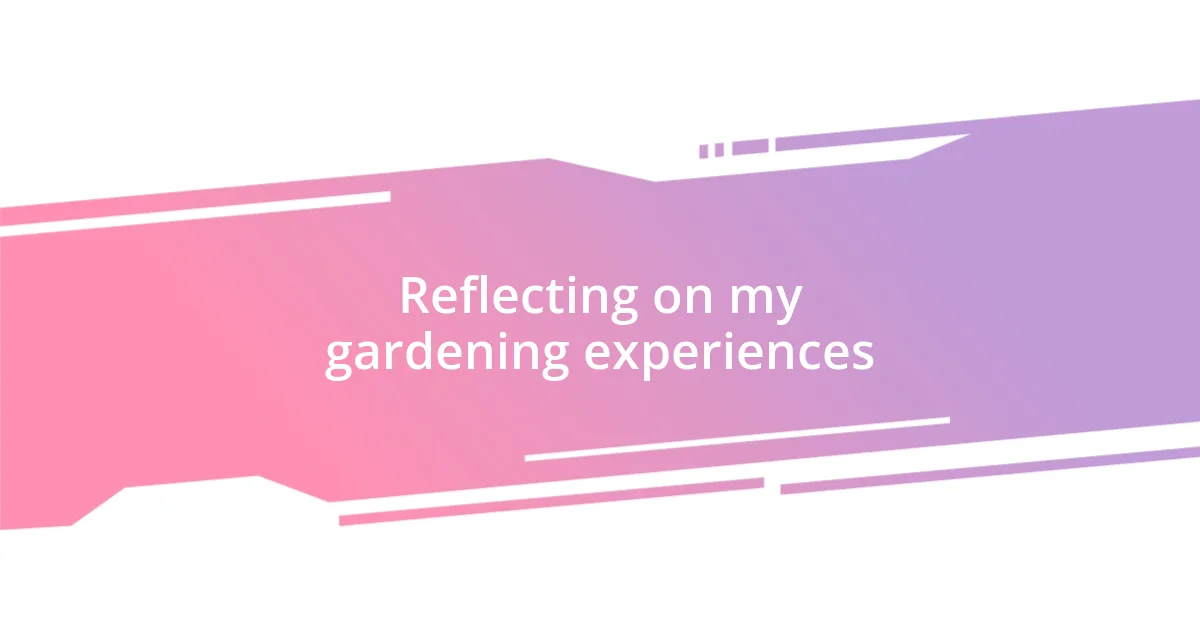Key takeaways:
- Emphasizing coexistence and embracing imperfection in gardening fosters resilience and beauty in nature.
- Understanding local climate and soil conditions is crucial for selecting the right plants that thrive harmoniously.
- Effective watering practices, organic pest management, and seasonal strategies enhance overall garden health and productivity.

Understanding my gardening philosophy
Gardening, for me, transcends mere cultivation; it’s an ongoing dialogue between nature and myself. I remember the first time I watched a seedling break through the soil—its determination resonated deeply with me. How can something so small hold the power to transform a patch of earth into a vibrant ecosystem? This experience solidified my belief that gardening is a testament to resilience and the beauty of growth.
I’ve found that my gardening philosophy is rooted in the idea of coexistence. I often reflect on the diverse array of creatures that call my garden home—from the fluttering butterflies to the industrious ants—and I relish the harmony that unfolds. Seeing a bumblebee buzzing happily from flower to flower reminds me that each element in the garden plays a vital role. Isn’t it fascinating how each living thing contributes to a thriving environment?
Embracing imperfection is another cornerstone of my gardening approach. I still recall the day I let go of my need for a flawless garden and simply enjoyed the wildness that filled the space. The tangled vines and unexpected blooms taught me that beauty can lie in chaos. How liberating it is to recognize that every wilting leaf tells a story of resilience!

Choosing the right plants
Choosing the right plants can make or break your gardening experience. I’ve learned over the years that understanding my local climate and soil type is crucial. For instance, when I first started, I eagerly planted tropical flowers in my cooler climate. They struggled, and it was disheartening to watch them wilt. Since then, I’ve focused on native plants that thrive effortlessly in my garden, and the difference is remarkable.
Here’s what I recommend when selecting plants for your garden:
- Research Local Conditions: Understand your USDA hardiness zone to choose plants that will thrive in your climate.
- Consider Sunlight Requirements: Some plants love full sun, while others prefer shade; I always scout my garden for both before planting.
- Soil Type Matters: Testing soil pH and drainage can help ensure the plants you want to grow will flourish.
- Seasonal Interest: I love plants that bloom in different seasons, adding a touch of freshness throughout the year.
- Companion Planting: Some plants grow better together, so I always consider their benefits for pest control and growth when making selections.
By applying these insights, I’ve. cultivated a garden that not only pleases the eye but also feels like a sanctuary where plants thrive harmoniously.

Creating the ideal soil
When it comes to creating ideal soil, I’ve learned that starting with the right foundation is essential. My journey began with soil testing, a step I once overlooked. I remember the surprise of discovering my soil was more clayey than expected; it explained why my plants were struggling. After that realization, I started amending my soil with organic matter like compost and well-rotted manure, which improved its texture and fertility. The transformation was profound, not only for my plants but for my entire gardening experience.
I can’t emphasize enough how beneficial it is to incorporate various layers into your soil. The top layer enriches with nutrients, while the deeper layers provide the necessary drainage. This layered approach reminds me of the richness of a lasagna: each ingredient contributes to the whole dish’s flavor. I first tried this method in a raised bed, and the results were amazing! The flowers flourished like never before, and it felt like an achievement I could physically touch.
Understanding the importance of microbes in the soil ecosystem also revolutionized my gardening. I recall the day I started a worm bin; it felt like bringing a little magic into my garden. These tiny helpers break down organic material and create nutrient-rich compost that my plants can’t get enough of. By consistently enriching my soil with these natural amendments, I’ve cultivated an environment where plants not only survive but thrive.
| Aspect | Importance |
|---|---|
| Soil Testing | Identifies pH and nutrient deficiencies |
| Organic Amendments | Improves soil fertility and structure |
| Layering Techniques | Enhances drainage and nutrient retention |
| Microbial Health | Supports plant growth and resilience |

Effective watering techniques
Effective watering is like nurturing a relationship; it requires attention and understanding. I’ve discovered that the timing of watering can make a significant difference. For example, I always aim to water in the early morning. It’s peaceful, and I can watch the dew glisten on the leaves—it reminds me to appreciate the small joys in gardening. Plus, watering early helps reduce evaporation and ensures my plants get the moisture they need to start their day strong.
One technique I swear by is deep watering. When I first began gardening, I made the mistake of surface watering—just a quick sprinkle. It took me a while to realize that roots grow deep in search of moisture. Now, I water thoroughly but less frequently, which encourages those roots to stretch out. Trust me, watching my plants perk up after a deep soak is one of the most rewarding experiences. Have you ever seen a wilted plant revive with just a bit of patience? It’s like witnessing a miracle.
Drip irrigation has become my best friend for efficient watering. I remember the summer I was nearly defeated by the heat. Hand-watering seemed endless, and I often missed spots. Installing a drip system not only saved time but also allowed me to conserve water. Each plant gets just the right amount they need without waste. I couldn’t believe I hadn’t done it sooner—what a game-changer! It’s like giving my garden a spa day every day, and who wouldn’t want that for their plants?

Managing pests and diseases
Managing pests and diseases can feel daunting, but I’ve found that prevention is often the best strategy. One summer, I was devastated to find aphids all over my beloved roses. I learned the hard way that a strong, healthy plant is more resilient to pests. Now, I focus on nurturing my garden’s natural balance by planting companion plants—like marigolds near vegetables—because they can deter pests naturally. Have you ever noticed how certain plants seem to thrive together? It’s fascinating how nature works!
When those pesky invaders do appear, I’m quick to spring into action with organic solutions. I remember when I first tried making a garlic spray; I had a pesky caterpillar problem. That homemade remedy not only cleared out those unwanted guests but also made me feel like a true garden warrior! I always emphasize trying natural methods first, as they are kinder to the environment and keep beneficial insects safe. It’s rewarding to solve problems without resorting to harsh chemicals.
Disease management has been another area I’ve explored thoroughly. One year, I faced powdery mildew on my squash, and I felt a wave of panic. Instead of giving in, I researched and found that increasing air circulation and proper spacing made all the difference. Now, I’m diligent about regular inspections, always looking for early signs of trouble. Does that pique your interest? Finding early interventions saves time and energy, not to mention the heartache of seeing plants struggle.

Seasonal gardening strategies
Seasonal gardening strategies are pivotal to cultivating a thriving garden. As spring approaches, I can hardly contain my excitement for the plantings ahead. I usually start with cool-season crops like lettuce and peas. There’s something magical about watching those first seeds sprout; it’s like the garden is awakening after a long slumber. Have you ever felt that rush of anticipation when you see your hard work start to pay off?
During the summer months, I’ve learned the value of crop rotation. I remember a year when I didn’t rotate my tomatoes and faced nasty blight. Now, I take special care to position crops in new locations each season, which not only prevents diseases but also enriches the soil. It’s a simple yet effective practice that keeps my garden balanced and productive. What strategies do you use to keep things fresh in your garden?
As autumn rolls in, I focus on preparing for winter. Mulching has become one of my favorite tasks; it feels rewarding to snuggle the plants in a cozy blanket of leaves or straw. This layer of protection doesn’t just keep the roots warm; it also prevents weeds from stealing nutrients. Have you ever been amazed at how a little extra care can make such a significant difference? I find that taking these steps helps me reflect on the gardening cycle and get ready for the joys of spring once again.

Reflecting on my gardening experiences
Reflecting on my gardening experiences brings a wave of nostalgia. I remember the first time I stepped into my garden; it was a dense jungle of weeds and untamed sprouts. Initially, I felt overwhelmed, but as I dug in and began clearing out the chaos, I discovered a surprising sense of calm. Have you ever found serenity in the simple act of nurturing life? It made me realize how gardening can be as much about personal growth as it is about cultivating plants.
One season, I took the leap to try growing heirloom tomatoes. I was drawn by their unique shapes and vibrant colors, but little did I know the lessons ahead. Amidst the struggle against diseases and pests, I found myself developing patience and resilience—qualities I realized I needed in my life too. Each tomato harvest was a small victory, and I often found myself sharing them with friends. The joy on their faces was as rewarding as the fruit itself. Have you ever celebrated your gardening triumphs with loved ones? Those shared moments became cherished memories.
Every year, I also find myself reflecting on my early mistakes, like the time I forgot to check the soil pH before planting my cucumbers. The result was a poor yield that left me deflated. Instead of sulking, I turned that mishap into a learning experience, diving deeper into soil health. Now, soil testing has become a regular ritual for me. It’s remarkable how acknowledging our missteps can foster growth—both in gardens and in ourselves. How do you embrace your gardening challenges?














